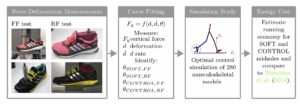Virtual Footwear Design
Abstract
Testing sports equipment with athletes is costly, time-consuming, hazardous and sometimes impracticable. We propose a method for virtual testing of running shoes and predict how mid- soles made of BOOSTTM affect energy cost of running. We contribute a visco-elastic contact model and identified model parameters based on load-displacement measurements. We propose a virtual study using optimal control simulation of musculoskeletal models. The predicted reduction in energy cost of ~1% for BOOSTTM in comparison to conventional materials is consistent with experimental studies. This indicates that the proposed method is capable of replacing experimental studies in the future.
Overview

Figure: Overview of methods
Publications
- Dorschky E., Krüger D., Kurfess N., Schlarb H., Wartzack S., Eskofier B., van den Bogert AJ.:
Optimal control simulation predicts effects of midsole materials on energy cost of running
In: Computer Methods in Biomechanics and Biomedical Engineering (2019)
ISSN: 1025-5842
DOI: 10.1080/10255842.2019.1601179
URL: https://www.mad.tf.fau.de/files/2019/08/201904_CMBBE_Dorschky.pdf
BibTeX: Download
- Nitschke M., Luckfiel T., Schlarb H., Dorschky E., Koelewijn A.:
Prediction of the effect of midsole stiffness and energy return using trajectory optimisation
15th biennial Footwear Biomechanics Symposium (Online, 21. July 2021 - 23. July 2021)
In: Footwear Science 2021
DOI: 10.1080/19424280.2021.1917684
URL: https://www.mad.tf.fau.de/files/2023/05/FBS_2021_SoftvsEnergy_Submission_AOM_Declaration.pdf
BibTeX: Download
